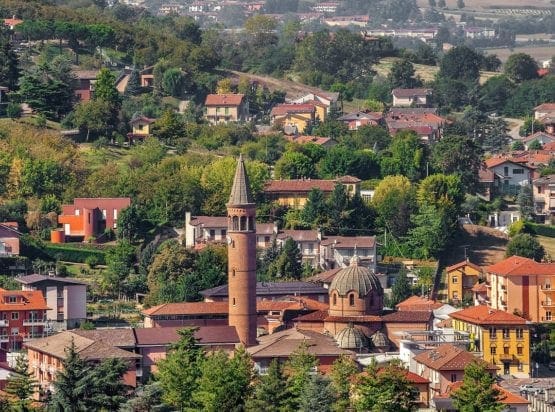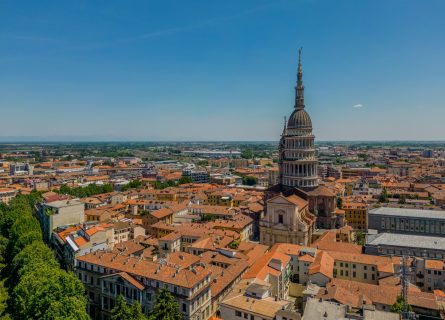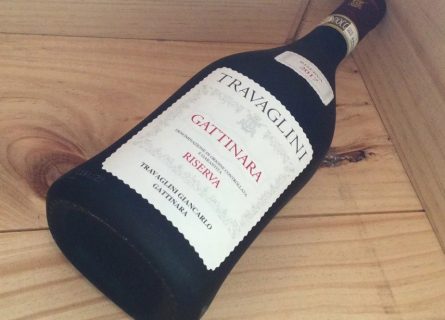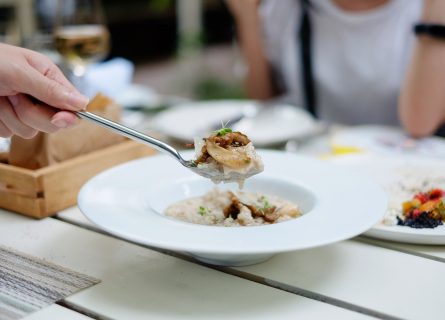Discover Alba, Piedmont's culinary jewel, famed for truffles and wines. Explore rich history and gourmet paradise in Italy's food and wine capital.
Read more
EXPLORE ALL OUR PIEDMONT WINE REGION GUIDE
Last updated: July 25, 2024
Alto Piemonte, a region still in its winemaking infancy, is rapidly evolving in quality. Situated to the northeast of Turin, this once challenging area for late-ripening varieties like Nebbiolo is now a hotbed of innovation. The region’s cool climate, which historically struggled to yield berries with sufficient sugar levels, is now a unique selling point, resulting in wines with high acidity and a desirable profile.
But, as winemaker Oscar Arrivabene so aptly observes:
“Alto Piemonte is on fire at the moment, as more and more investors regard the zone as a key future terroir for Nebbiolo. The soils and climate naturally give high acidity in the wines, something which is obviously desirable. This is what climate change does – everyone looks to move higher and cooler. One day, we may decide to take the plunge ourselves.”
It would be a wise choice. Some of Italy’s best Nebbiolo is now made in Gattinara and Ghemme. These two DOCG appellations, found on opposite sides of the Sesia River in the shadow of the majestic Alps, are on the brink of a revolution.
With each new vintage, they continue to surprise and reward, hinting at a future where Gattinara and Ghemme could stand shoulder-to-shoulder with Barbaresco as a seminal destination for the Nebbiolo grape. In the dynamic and rapidly evolving world of Italian viticulture, this once far-fetched idea is now becoming a reality.

The vineyards of Alto Piemonte represent the last frontier of Nebbiolo winemaking. It is a name given to a group of subregions in the far northeastern corner of Piedmont, close to the province of Valle d’Aosta. They continue to produce supremely elegant – and amazing value – Nebbiolo-based reds with a complex history. Indeed, Gattinara and Ghemme’s fame outstripped that of Barolo and Barbaresco in the early 1800s before phylloxera destroyed much of the acreage in northwestern Italy.
In the aftermath, winemakers focused on the warmer vineyards of the Langhe hills, while Alto Piedmonte’s cooler climate was not conducive to producing red wines of weight and alcohol. As a result, the area was largely neglected until climate change instigated a resurgence of interest in the early 21st century.
Today, at least ten different designations make high-quality red wines in Alto Piemonte, including the (justifiably) lauded Gattinara and Ghemme. Both zones have been awarded DOCG status, with 100 and 85 hectares under vine, respectively. The vineyards are cultivated in the hills above Novara and Vercelli ( a center of rice production) and planted on ancient volcanic soils rich in minerals.
Gattinara’s vignoble spreads out in all directions from the eponymous small town on the Sesia River’s left bank. This river flows due south from Borgosesia to join the River Po, moderating the sub-Alpine climate (cold winters and warm, dry summers) in the process.
Meanwhile, Ghemme is situated on the river’s eastern bank, close to the town of Borgomanero. Like Gattinara, it is greatly admired for its superior terroir and rising influx of talent – emigres from the vineyards of the Tanaro. These include the famous Giacomo Conterno of Barolo; after much deliberation, he purchased a small estate called Nervi in Gattinara in 2018.
Elevation and Climate Adaptation
Nervi and other vineyards in Alto Piemonte benefit from several natural advantages, including rolling hills and steep slopes, south-facing climats (vineyard sites), and considerable elevation. These last two points are critical: good exposure provides enough warmth and sunlight to ripen Nebbiolo before the rainy season begins.
Inland, especially at higher altitudes, later-flowering grape varieties like Spanna (the local synonym for Nebbiolo) traditionally struggled to achieve phenolic ripeness in Alto Piemonte; however, global warming has completely upended expectations in the vineyards of Ghemme and Gattinara.
Thus, elevation is now used to moderate the intense summer heat, rising to over 450 meters above sea level. Meanwhile, vines also lap up the additional warmth reflected back into the canopy from the gravel soils, resulting from millions of years of glacial activity. These free-draining volcanic terroirs, rich in minerals and ideally situated, yield world-class Nebbiolo wines, showcasing the unique impact of climate change on the region’s viticulture.

The production of exceptional Nebbiolo wines in Alto Piemonte is on the rise, driven by a combination of exceptional soils and local winemakers’ refined, location-specific techniques. What remains to be seen is whether this success can be duplicated as the acreage inevitably expands and volumes rise.
So far, the indications are mainly positive. Ghemme and Gattinara are blessed with a critical mass of premium wineries that seek quality, not quantity, from their raw materials. The Gattinara framework, promoted to DOCG status in 1990, stipulates that every bottle of wine must have a minimum ABV of 12.5% ( 13% for the Riserva category) and be matured in wood for 12 months before release. This attention to detail and quality is a hallmark of the region’s winemaking.
Rigorous Aging Standards for Riservas
Meanwhile, winemakers keep Riservas in a barrel for two years, although keeping them too long in a cask can overwhelm these relatively delicate and amazingly long-lived reds. The rules governing the production of Ghemme are quite similar: winemakers age the wines for 36 months before commercial releases (20 months in barrel) with a minimum of nine months in bottle. Winemakers leave the top-tier, small-production Riserva category in wood for at least 24 months (48 in total) before it hits the market – they usually surpass a target alcohol content of 12.5 percent or higher in most vintages.
Yet, their flexible approach to blending truly sets the wines of Ghemme and Gattinara apart. Unlike Barolo and Barbaresco, winemakers can add a small percentage of local grape varieties—Bonarda di Gattinara (Uva Rara), Bonarda di Novarese, and Vespolina—to the wine to enhance its perfume and structure.
This brings us nicely onto the subject of winemaking in Piedmont and the evolution of ideas that started with Angelo Gaja in the 20th century. The traditional paradigm – long extractions at high temperatures and extended aging in old vats – was replaced with a fruit-first philosophy heavily influenced by trips to key French regions. Suddenly, vinification in stainless steel, shorter macerations, and a spell in new French oak were all the rage. The resulting wines were softer and more approachable than anything seen before in the hills of northwestern Italy.
Focus on Elegance and Subtlety
Ultimately, it is not the goal of most winemakers in Alto Piemonte to outgun their rivals with immense concentration and muscular tannins. Instead, they aim to surpass them in elegance, subtlety, and finesse. To that end, many producers ferment their wines in a mixture of steel and concrete, an option now widely favored by modernists and traditionalists.
The maceration time will vary across wineries and vintages, although a happy middle ground (up to three weeks) tends to yield the best results: supple and balanced wines that retain enough tannin to age for at least 15 years or more.
Moreover, freshness and fruit are a top priority in Ghemme and Gattinara, so the required tannin content sways the maturation vessel choice. 100 percent new barrique is best avoided for this reason: adding oak-derived structure can overwhelm a variety like Nebbiolo, as there is no paucity of tannin to start with!
Nevertheless, Nebbiolo is always a tannic wine that benefits enormously from bottle age, regardless of how it is made. Poor examples from Ghemme and Gattinara will allow this structure to dominate the fruit; great wines offer a balance of tannic grip and ripe fruit, with attractive aromas of raspberry, leather, and plum on the nose. Over time, these will evolve into tertiary flavors and complex characteristics – the whiff of incense, forest floor, and truffles suggest a mature Nebbiolo in the prime of life. The pleasure they deliver to wine lovers is almost indescribable.
In the 19th century, wine critics regarded the wines of Alto Piemonte more highly than those from the (now) hallowed vineyards of Barolo and Barbaresco. It was only after the phylloxera epidemic of the late 1800s that Ghemme and Gattinara became bit players in Piedmont’s glorious Nebbiolo revolution. This was the climax of shifting priorities and a newfound obsession with developing the Langhe hills and their clay-limestone soils. By the mid-20th century, investors had forgotten about Alto Piemonte and its ancient volcanic terrain.
Revival and Modern Excellence in Alto Piemonte
Yet, producer priorities have shifted again, driven by global warming and the search for cooler terroirs. Today, this corner of Piedmont is buoyant with emerging wineries and renewed investment. It is an area of similarities and contrasts, where Gattinara and Ghemme are defined by their gravel soils and favorable mesoclimates and where different viticultural and winemaking philosophies can flourish. Gattinara is larger and more established, while Ghemme has some genuinely exceptional growers working on the right bank of the Sesia. Both are making increasingly impressive red wines.
The only potential stumbling block is the necessity of patience. For some wines, bottle age is beneficial; for Alto Piemonte, it is vital. Indeed, the Nebbiolo wines of Ghemme and Gattinara can be overwhelming in their youth, delivering a mouthful of very firm tannin that occasionally veers into astringency.
Maturation Strategy for Optimal Enjoyment
Therefore, we recommend laying down your purchases for a few years to get the best out of them. But is that so bad? After all, connoisseurs know that it doesn’t matter how top-end Barolo tastes, in comparative terms, during its infancy. What’s important is how these magnificent reds taste when they reach their successive stages of maturity. And the best of Ghemme and Gattinara, rising stars in the expanding pantheon of Italian wines, are no different. Lay your prized bottles down in the cellar for a decade, and prepare to be richly rewarded.
Nebbiolo is an Italian red grape primarily linked to Piedmont, where it creates prestigious DOCG wines like Barolo, Barbaresco, and others. Its name may come from "nebbia" or "nebia," signifying the fog that envelops Piedmont during late October harvests. Nebbiolo wines are light in color but can be intensely tannic when young, offering scents of tar and roses. They develop a brick-orange rim with age, revealing aromas like violets, truffles, cherries, and tobacco.
Uva Rara is a red Italian grape variety cultivated in Piedmont and Lombardy, mainly used for blending. It is permitted in Ghemme's DOCG wines alongside Nebbiolo and often blended with Barbera and Croatina in Oltrepò Pavese's DOC region. Despite its name meaning "rare grape" in Italian, Uva Rara is quite common

You can find some very fine osteries and restaurants in Gattinara, particularly on the bustling Corso Vercelli and Via Francesco Mattai. They tend to be fairly modest in size – intimate eateries that are perfect for a romantic meal for two. But, the overall standard of cooking is exceptional; chefs are proud of their authentic Piemontese pasta and risotto dishes, not least the Tagliolini alla Langarola, dusted with super-pungent shavings of white truffle. Magnifico!

Discover Alba, Piedmont's culinary jewel, famed for truffles and wines. Explore rich history and gourmet paradise in Italy's food and wine capital.
Read more
Torino: A dynamic blend of royal history, industrial innovation, and cultural vibrancy, nestled in Italy's scenic northwestern Alps.
Read moreIf you would like us to customize an exclusive luxury tour, contact us and let us know your travel plans. We offer luxury food and wine tours for private groups of a minimum two guests. In addition, all of our private, chauffeured tours are available year-round upon request.

